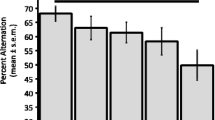Abstract
We studied the effects of administration of the new nootropic drug phenotropil (N-carbamoylmethyl-4-phenyl-2-pyrrolidone) at a dose of 100 mg/kg on the quantitative characteristics of dopamine (DA), serotonin (5-HT), glutamate (NMDA), GABA-A (BDZ), and acetylcholine (nACh) receptors in rats using the conditioned passive avoidance task (PAT) under normal conditions and during scopolamine-induced amnesia ex vivo. We found that the cholinolytic drug scopolamine induced a substantial increase in the density (B max) of n-choline receptors in the cortex (by 99% as compared to the control) and NMDA receptors in the hippocampus (by 93%). A single administration of phenotropil (100mg/kg, intraperitoneally) abolished the effect of scopolamine and decreased the number of nACh and NMDA receptors by 46% and 14%, respectively. Phenotropil also abolished the effect of scopolamine on the benzodiazepine receptors and dopamine D1 receptors. Scopolamine decreased the density of D1 receptors by 20% and BDZ receptors by 17%, whereas phenotropil increased the density of receptors by 16% and 25%, respectively. Phenotropil considerably increased the density of dopamine D2 and D3 receptors by 29% and 62%, respectively. Scopolamine also increased the density of D3 receptors by 44% as compared to the control. We did not find any changes in the binding characteristics of 5-HT2 receptors during scopolamine-induced amnesia or during phenotropil treatment. These results demonstrate the role of these receptors in the development of scopolamine-induced amnesia and in neurochemical mechanisms of the anti-amnestic effects of phenotropil.
Similar content being viewed by others
References
Akhapkina, V.N., Fenotropil. Sb. St., 2007, pp. 6–14.
Filippova, S.Yu., Aleshina, N.V., and Stepanov, V.P., Fenotropil. Sb. St., 2007, pp. 84–87.
Kovalev, G.I., Akhapkina, V.I., Abaimov, D.A., and Firstova, Yu.Yu., Atmosfera. Nervnye Bolezni, 2007, no. 4, pp. 22–26.
Kovalev, G.I. Doctorate (Med.) Dissertation [in Russian], Moscow: NII farmakologii im. V.V. Zakusova, 1993.
Zhao, X., Kuryatov, A., Lindstrom, J., Yah, J., and Narahashi, T., Mol. Pharmacol., 2001, vol. 59(4), pp. 674–683.
Firstova, Yu.Yu., Cand. Sci. (Biol.) Dissertation [in Russian], Moscow: NII farmakologii im. V.V. Zakusova, 2008.
Kovalev, G.I. and Prikhozhan, A.V., Farmakologiya nootropov. Eksperimental’noe i klinicheskoe izuchenie. Val’dman A.V., Voronina T.A., Eds., Moscow, 1989, pp. 99–104.
Kovalev, G., Kudrin, V., Zharikov, S., Pogorelov, V., Bogdanov, M., and Guinetdinov, R., Abstr. of Meeting Dopamine-92, Italy, 1992, p. 29.
Copani, A., Genezzani, A.A., Aleppo, G., Casadona, G., and Canonico, P.L., J. Neurochem., 1992, vol. 58, pp. 1199–1204.
Narahashi, T., Moriguchi, S., Zhao, X., Marszalec, W., and Yeh, J.Z., Biol. Pharm. Bull., 2004, vol. 27(11), pp. 1701–1706.
Voronina, T.A. and Ostrovskaya, R.U., in Rukovodstvo po eksperimental’nomu (doklinicheskomu) izucheniyu novykh farmakologicheskikh veshchestv (Manual on Experimental (Preclinical) Studies of New Pharmacological Compounds), Moscow, 2000, pp. 153–158.
Glowinski, J. and Iversen, L., J. Neurochem., 1966, vol. 13(8), pp. 655–669.
Alexander, S.P., Mathie, A., and Peters, J.A., Guide to Receptors and Channels. BJP, 2006, vol. 147, no. 3, p. 146.
Sun, W., Ginovart, N., Ko, F., Seeman, P., and Kapur, S., Mol. Pharmacol., 2003, vol. 63(2), pp. 456–462.
Romano, C. and Goldstein, A., Science, 1980, vol. 210, pp. 647–650.
Zhou, L.M., Gu, Z.Q., Costa, A.M., Yamada, K.A., and Manssone, P.E., J. Pharmacol. Exp. Ther., 1997, vol. 280, pp. 422–427.
Andersen, P.H., Gronvald, F.C., and Jansen, J.A., Life Sci., 1985, vol. 37, pp. 1971–1983.
Levesque, D., Diaz, J., Pilon, C., Martres, M.P., Giros, B., Souil, E., Schott, D., Morgat, J.L., Schwartz, J.C., and Sokoloff, P., Proc. Natl. Acad. Sci. USA, 1992, vol. 89, pp. 8155–8159.
Cohen, S.A. and Mller, W.E., Pharmacol., 1993, vol. 47, pp. 217–222.
Pilch, H. and Mller, W.E., Psychopharmacol., 1988, vol. 94, pp. 74–78.
Pepeu, G. and Sprignoli, G., Prog. Neuropsychopharmacol. Biol. Psychiatry, 1989, vol. 13, pp. 77–88.
Pepeu, G., Sprignoli, G., and Goivannini, M.G., Pharmacopsychiatry, 1999, vol. 22(2), pp. 116–119.
Yamada, K., Tanaka, T., and Mamiya, T.I., Brit. J. Pharmacol., 1999, vol. 126(1), pp. 235–244.
Scheuer, K., Rostock, A., and Bartsh, R., Pharmacopsychiatry, 1999, vol. 32, pp. 10–16.
Memo, M., Missale, C., Trivelli, L., and Spano, P.F., Eur. J. Pharmacol., 1988, vol. 149(3), pp. 367–370.
Stewart, M.G., Kabai, P., Harrison, E., Steele, R.J., Kossut, M., and Csillag, A., Neuroscience, 1996, vol. 70(1), pp. 7–14.
Nitta, A., Katono, Y., Itoh, A., Hasegawa, T., and Nabeshima, T., Pharmacol. Biochem. Behav., 1994, vol. 49(4), pp. 8072–8080.
Dubrovina, N.I., Neurosci. Behav. Physiol., 2006, vol. 36, no. 6, pp. 679–684.
Aramakis, V.B. and Metherate, R., J. Neurosci., 1998, vol. 18, pp. 257–263.
Gould, Th.J. and Lewis, M.C., Learn. Mem, 2005, vol. 12, pp. 389–398.
Lloyd, G.K. and Williams, M., J. Pharmacol. Exp. Ther., 2000, vol. 292(2), pp. 461–467.
Mohler, H., Fritschy, J.M., and Rudolph, U., J. Pharmacol. Exp. Ther., 2002, vol. 300(1), pp. 2–8.
Author information
Authors and Affiliations
Corresponding author
Additional information
Original Russian Text © Yu.Yu. Firstova, D.A. Abaimov, I.G. Kapitsa, T.A. Voronina, G.I. Kovalev, 2011, published in Neirokhimiya, 2011, Vol. 28, No. 2, pp. 130–141.
Rights and permissions
About this article
Cite this article
Firstova, Y.Y., Abaimov, D.A., Kapitsa, I.G. et al. The effects of scopolamine and the nootropic drug phenotropil on rat brain neurotransmitter receptors during testing of the conditioned passive avoidance task. Neurochem. J. 5, 115–125 (2011). https://doi.org/10.1134/S1819712411020048
Received:
Published:
Issue Date:
DOI: https://doi.org/10.1134/S1819712411020048




